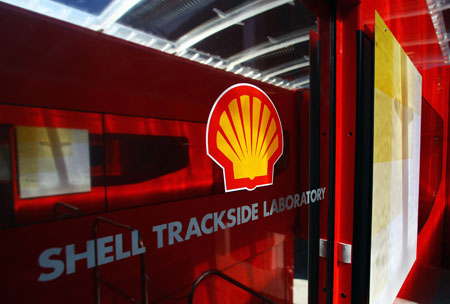
We were fortunate to be among the journalists hosted by Shell over the Singapore GP last month – not only did we get to watch the exciting race under the stars (my first time doing so as a spectator from the grandstand, see the pics here), we also got to dig deeper into what makes Shell V-Power different, got some drive time in a Lotus Elise and visited the Shell Track Lab in the F1 paddock.
Shell and Ferrari have been partners since the Italian company started making road cars in 1947 and they were also on the grid together at the first ever round of the Formula One World Championship in 1950. Since then, the Scuderia, with Shell fluids in its engines, has competed in 463 races (as of S’pore GP), won 12 Drivers’ titles and 10 Constructors’ titles on its way to become the most famous and instantly recognisable racing team in the world.

Shell is also the biggest Ferrari dealer in the world – it has sold 70 million Prancing Horse cars in the last four years! Of course we are talking about the toy cars that make an annual appearance at Shell stations. Did you know that Malaysian sales of the model cars are among the top three worldwide?
Continue reading the story after the jump.
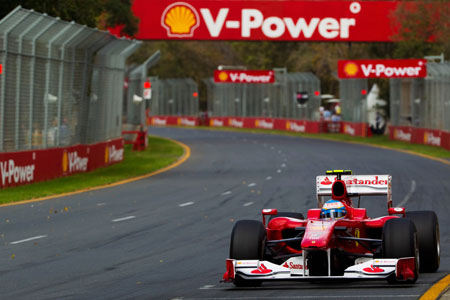
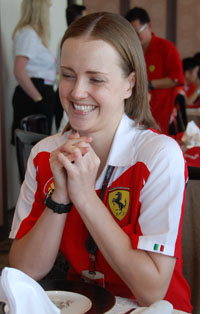 Anyway, Shell is very proud of this relationship, and rightly so, as the oil company reminds us that it’s a technical partnership they have with Ferrari, not a sponsorship. Lisa Lilley, Shell’s Technology Manager for Ferrari (seen here praying for a Ferrari win), has about 50 scientists working in her team, and she even has an office in Ferrari’s Gestione Sportiva Maranello HQ.
Anyway, Shell is very proud of this relationship, and rightly so, as the oil company reminds us that it’s a technical partnership they have with Ferrari, not a sponsorship. Lisa Lilley, Shell’s Technology Manager for Ferrari (seen here praying for a Ferrari win), has about 50 scientists working in her team, and she even has an office in Ferrari’s Gestione Sportiva Maranello HQ.
But a bigger sign of Shell’s place in Ferrari’s F1 team is the Shell Track Lab, which travels with the Scuderia to every race, occupying 25% of the team motorhome. We were told that it’s the only such setup in the paddock.
It’s a very tight and hot room, and we just about fit inside without knocking over the expensive equipment. Engineer Gareth Lowe explained that fuel and engine oil samples are taken from the car before and after every session (practice, qualifying, race) for analysis. An advanced gas chromatograph in the Track Lab separates the many compounds and components in the lube and race fuel for analysis. There are over 200 components in the race fuel and a staggering 2,000 litres are brought to each race. As for lubes, Shell provides Ferrari with 40 tonnes of Helix Ultra over a season.
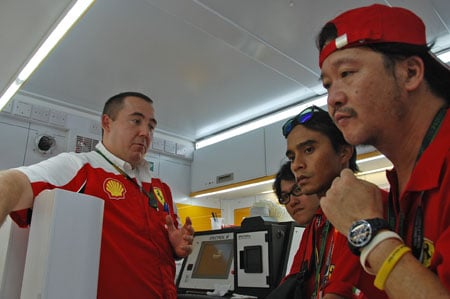
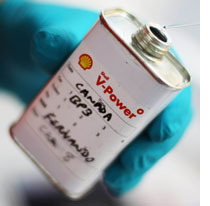 On average, the Shell team (minimum of three engineers at every F1 race) analyses the fuel up to 40 times throughout a race weekend to ensure that everything is within legal boundaries.
On average, the Shell team (minimum of three engineers at every F1 race) analyses the fuel up to 40 times throughout a race weekend to ensure that everything is within legal boundaries.
We were told that between lubricants and fuel, it’s the latter that is more tightly regulated by the FIA, and there are strict chemical and physical parameters set for race fuel. “Fingerprints” of the fuel are send to the governing body before it’s used and the FIA can also drop in any time to do a “spot check”. Cross the line and the team can be disqualified.
The Shell team’s race weekend starts on Wednesday, when Scuderia Ferrari trucks or containers for flyaway races arrive at the track. It’s all setup work, and scientists run initial tests on the instruments to ensure all is in good working order. Although there’s no on-track action on Thursday, the cars are prepped up and ready to run. It is now that Shell takes samples from the car, the carlotta (the machine used to transfer fuel in and out of the cars) and from the drums to ensure there’s no contamination.
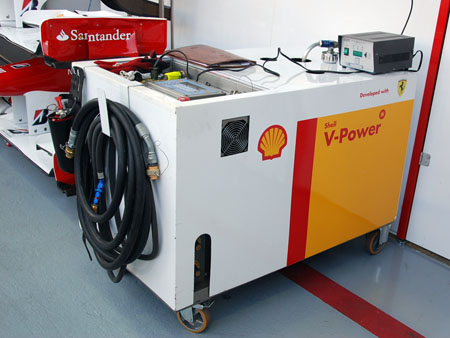
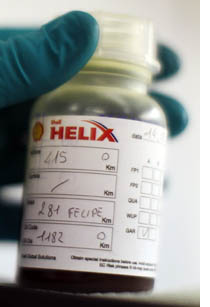 Friday is practice day, and fuel samples are taken from each car and carlotta before they hit the track. After each run, Shell will take an oil sample from the cars to measure the wear metal (the engine leaves behind residue as it works); the test results gives Ferrari an in-depth look at the condition of the engine.
Friday is practice day, and fuel samples are taken from each car and carlotta before they hit the track. After each run, Shell will take an oil sample from the cars to measure the wear metal (the engine leaves behind residue as it works); the test results gives Ferrari an in-depth look at the condition of the engine.
This is very important as each driver is allocated eight engines for the entire season. Exceed this and he will drop 10 places on the starting grid whenever an additional unit is used.
Samples taken before Saturday qualifying are highly important, as the car will leave the pits with race fuel loads on board. Results of the oil analysis is crucial at this point as it gives a marker as to how hard the engine can be pushed during the race. If the health of the engine isn’t at optimum levels, there’s little chance that the driver can push flat out for the entire race distance, for instance.
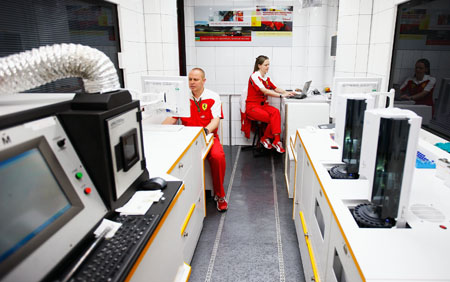
All the hard work leads to Sunday, but there’s no immediate happy hour right after the race, even if Fernando wins. Once the cars are in Parc Ferme, Shell is still allowed to to take samples as a final fail safe. If the FIA decides to do a random fuel test on a Ferrari, Shell would run the same test to ensure results are consistent. When the cars are released back to the team, oil samples are sent back to Shell’s labs in the UK for full analysis. The results are then shared with Ferrari within days as part of a full debrief.
It’s more than just that famous yellow logo on the car, as Shell plays an integral part in Ferrari’s Formula 1 exploits. Although we only scraped the surface with this story, I hope that it brought you a little closer to what goes on behind the scenes and the role of an oil company within an F1 team.
Looking to sell your car? Sell it with Carro.

